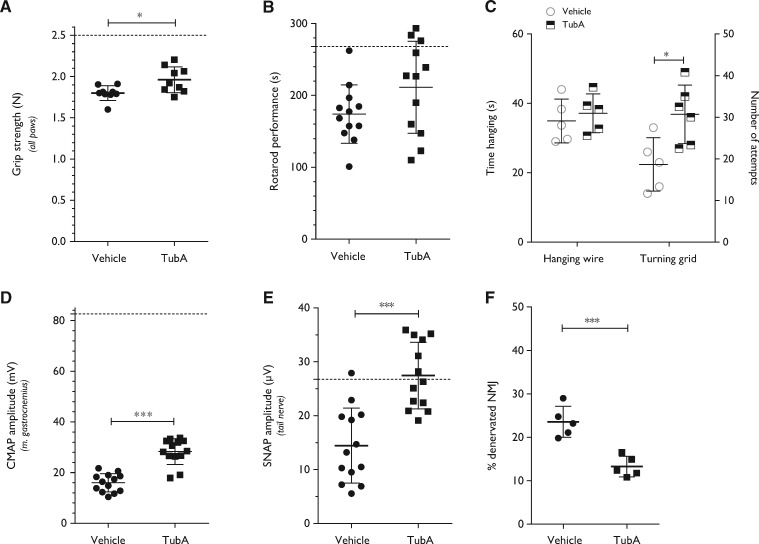Figure 6.
Treatment of GarsC201R/+ mice with a HDAC6 inhibitor improves motor behaviour and stimulates regeneration of motor and sensory nerves in 4-month-old mice. (A) After daily intraperitoneal injections during 40 consecutive days with tubastatin A (50 mg/kg), the grip strength in all paws of vehicle- versus tubastatin A-treated GarsC201R/+ mice was assessed: vehicle 1.80 ± 0.09 N, n = 9 mice versus tubastatin A 1.96 ± 0.16 N, n = 12 mice; unpaired t-test: t = 2.697, P = 0.0159. (B) The motor behaviour after treatment was measured by the accelerated rotarod test: vehicle 174 ± 40.47 s, n = 12 mice versus tubastatin A 211 ± 63.96 s, n = 12 mice; unpaired t-test: t = 1.706, P = 0.1021. (C) The time spent hanging (hanging wire) as well as the number of attempts to climb back on top of a grid (turning grid) was measured in vehicle versus tubastatin A-treated mice: turning grid test: vehicle 22.40 ± 7.70, n = 5 mice versus tubastatin A 36.83 ± 8.42, n = 5 mice; unpaired t-test t = 2.939, P = 0.0165. (D) The CMAP amplitudes were measured in the sciatic nerve in vehicle and tubastatin A-treated mice: vehicle 15.98 ± 3.61 mV, n = 13 mice versus tubastatin A 28.28 ± 5.09 mV, n = 13 mice; unpaired t-test t = 7.110, P < 0.0001. (E) SNAP amplitudes were measured in the tail nerve in vehicle and tubastatin A-treated mice: vehicle 14.45 ± 6.98 µV, n = 13 mice versus tubastatin A 27.45 ± 6.18 µV, n = 13 mice; unpaired t-test t = 5.027, P < 0.0001. (F) Quantification of the percentage of innervated neuromuscular junctions (NMJs) in the gastrocnemius muscle after treatment: vehicle 23.57 ± 3.58%, n = 5 mice (one muscle per mouse) versus tubastatin A 13.27 ± 2.38 %, n = 5 mice (one muscle per mouse); unpaired t-test t = 5.366, P = 0.0007.

